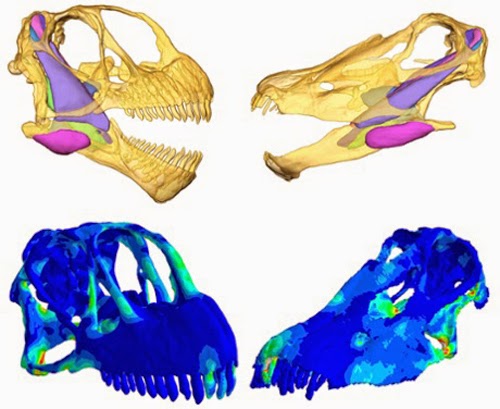
The giant sauropod dinosaurs such as Diplodocus and Apatosaurus are familiar thanks to their huge sizes and unique body shapes of a long neck and tail with a tiny head perched on top. Among their ranks were the largest terrestrial animals of all time, and yet an enduring mystery remains: how did so many animals of this size get to be so big?
Take a look at modern faunas. There are rarely more than one or two megaherbivores – multi-tonne giants that can (and generally do) eat any plant material they can get hold of. Although we are lacking a number of big species now thanks to various relatively recent extinctions, it is still pretty normal for mammal faunas to have only a handful of giant herbivorous species over a tonne or so.
For the sauropods, though, there were often numerous species (many of which would easily top 10 tonnes, and plenty were many times this figure) in the same ecosystem. Even allowing for the propensity of dinosaurs to get very big, this is something of an ecological anomaly. Large species are typically not too selective about what they eat (their size allows them to effectively digest even tough things like wood, while they can’t afford to be picky eaters and go for only small, if high-quality, foods such as seeds) so we would only expect a few species to be able to coexist.
A new study published in the Proceedings of the Royal Society of London, however, tackles this problem. It had been noted that the skulls and teeth of sauropods could be used to break them down into two basic groups: those with relatively lightly built skulls and teeth suitable for nipping, and animals with stronger skulls and larger teeth apparently more suitable for tougher foods. So researchers sought to compare the two for their mechanical performance and see if these different heads really were well suited for different tasks.
Digital scans were made of the skulls of Diplodocus and Camarasaurus – animals that lived alongside each other in the Jurassic of North America and that are now preserved in rocks termed the Morrison Formation. The two sauropods selected represent the nipping and strong skull types, respectively, and are excellent examples of the two basic forms and, unlike many sauropods, both have good skull material available. Based on marks on the skulls and comparisons to living animals, the muscles of the jaws could be added to the model to give the heads real bite. This then allows researchers to assess how much power could be delivered and how the arrangements of the heads would resist the forces from biting.
Camarasaurus was seen to have a much stronger bite and was better able to deal with such stress in the bones of the cranium. This implies they were adapted to a more coarse diet and although they doubtless would take what they could get, they would have been able to effectively handle tough, and especially woody, food. This is also a good match for wear marks on the teeth that indicate a diet of primarily coarse foodstuffs, but the pattern contrasts sharply with Diplodocus. Here the skull was weaker and could not deliver so powerful a bite. Instead the head seems better adapted to softer vegetation, and both wear on the teeth and adaptations seen in the bones of the neck show that these animals would feed by stripping branches and twigs of their leaves rather than biting through them.
The lead author on the study, David Button of the University of Bristol, said: “The Morrison Formation represents a particularly interesting case in Earth’s history as it presents a staggering diversity of sauropods, but yet was a seasonally semi-arid environment not conducive to excessive plant productivity. The results from our various analyses corroborate previous works looking at gross anatomy and tooth wear, and together give us a decent grounding of the ecology of these animals. Although a lot of work still needs to be done to refine this picture, we can see that their ecological interactions were really pretty sophisticated, which would have been important in supporting the observed diversity.”
A second analysis in the study compared a whole series of sauropod skulls in terms of their shape and structure. This shows that other sauropods in the Morrison that lived alongside Diplodocus and Camarasaurus fell somewhere on the gradient between these two extremes, or even adopted very different skulls shapes entirely.
In short, although these huge animals would have been strongly competing for food, they had evolved rather different ways of tacking the available plant material, which would have reduced competition between them. This separation would have been enhanced (in adults at least) by different neck lengths and body sizes, which would have facilitated different species feeding at different heights on the available plants, just as giraffe, rhino and zebra typically feed at different levels today. As Button notes, “sauropod skulls also provide interesting data in the broader context of the evolution of sauropod feeding mechanisms, where we see the repeated evolution of similar functional complexes.”
There is clearly further complexity to be unravelled here, for example juveniles of large species might well have interfered with the adults of those with a lesser reach, and some sauropod faunas have such huge diversity that a few different head shapes do not seem to separate them far enough to have allowed so many species to coexist. Even so, this analysis is a major step forwards in our understanding of sauropod evolution and ecology and how this group of enigmatic giants ate their way across the Mesozoic landscapes.
Note : The above story is based on materials provided by Dr Dave Hone for theguardian.com










